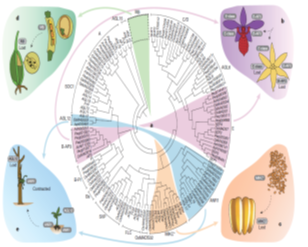Faculty: Wen-Chieh Tsai Professor

|
Name |
Wen-Chieh Tsai |
|
Position |
Professor and Director |
|
Telephone |
+886-6-2757575 ext.58310 |
|
|
|
|
Area of expertise |
Plant Evolutionary Development, Genomics, Molecular Biology |
![]()
Research Focuses: Chloroplast Degradation and Stress Physiology
I. Orchid Comparative Genomics
Constituting approximately 10% of flowering plant species, orchids display unique flower morphologies, possess an extraordinary diversity in lifestyle, and have successfully colonized almost every habitat on Earth. Comparison of orchid genomes could improve our understanding of their origins and evolution. We are interested in exploring the orchid genomes with genomics tools and try to uncover the evolution mystery of orchid by comparative genomics.
1. Cai et al. (2015) The genome sequence of the orchid Phalaenopsis equestris. Nature Genetics 47: 65-72.
2. Zhang et al. (2016) The Dendrobium catenatum Lindl. genome sequence provides insights into polysaccharide synthase, flower development and adaptive evolution. Scientific Reports 6: 19029.
3. Zhang et al. (2017) The Apostasia genome and the evolution of orchids. Nature 579: 379-383

II. Orchid Floral Evolutionary Development
The diversity and specialization in orchid floral morphology have fascinated botanists and collectors for centuries. The complex flower organization of orchids offers an opportunity to discover new variant genes and different levels of complexity in the morphogenesis of flowers. We are interested in molecular development and evolutionary trajectory of orchid floral morphogenesis.
1.Chen et al. (2012) C- and D-class MADS-box genes from Phalaenopsis equestris (Orchidaceae) display functions in gynostemium and ovule development. Plant and Cell Physiology 53: 1053-1067.
2.Tsai et al. (2014) New insight into the regulation of floral morphogenesis. International Review of Cell and Molecular Biology 311: 157-182
3.Lin et al. (2016) Genome-wide identification and characterization of TCP genes involved in ovule development of Phalaenopsis equestris. Journal of Experimental Botany 67: 5051-5066

III. Orchid secondary metabolome
The use of orchids in herbal medicine has a very long history. Totally 365 plants, including several orchids are listed in the earliest known Shen Nung Pen Tsao Ching. It provides an important direction for people to understanding how to use orchids as herbal medicine. To discover the medical value of novel components in orchid plants is potential for investment.

![]() Journal and Conference Papers
Journal and Conference Papers
![]() Ministry of Science and Technology (MOST) Project
Ministry of Science and Technology (MOST) Project
